英语情景交际课件
高考英语学业水平测试复习第三部分题型Ⅰ情景交际课件

五、提供(帮助等)和应答(Offers and responses) 常用表达法: 1.Can/Could/Shall I help you? Would you like me to...? Is there anything(else)I can do for you? Do you want me to...? What can I do for you? Let me do/carry/help...(for you). Would you like some...? 2.Thanks.That would be nice/fine. That's very kind of you. Thank you for your help.
(2)在大多数场合,仅说:Thanks;Thank you;Thanks a lot.是不 够的,还需说些其他表示感激和非常高兴之类的话。如感谢别人 的宴请,可以这么说:The dinner was delicious.Thank you for your invitation. 三、道歉、遗憾和应答(Apologies, regrets & responses) 常用表达法: 1.Sorry./Pardon. I'm terribly/awfully sorry./I'm sorry for(about)... I'm sorry to.../have done that... I apologize. Forgive me (for...). I really didn't meavor of you? Would you do me a favor? Be kind enough to tell me the truth. 2.Yes./Sure./Certainly. Yes, (do) please. Of course(you may). Go ahead, please. That's OK/all right. Not at all. Well, if I can. I'd be glad to. With pleasure.
小升初小学六年级英语第六讲情景交际课件

考点十二 询问天气、时间、季节等
1.询问天气 (1)How's the weather? 此句型用来询问天气情况。如: —How's the weather today?今天天气怎么样? —It's sunny.天气晴朗。
(2)What's the weather like...? 这也是用来询问天 气的句型。如: —What's the weather like in Beijing? 北京天气怎么样? —It's windy and cold.有风并且寒冷。 (3)Is it...? 也可以运用一般疑 问句来询问天气情况。如: —Is it cloudy today?今天多云吗? —Yes, it is.是的,多云。
3.May/Can I speak to...please? 这 是当你打 电话想找 某人时 的常用句 型,意为 “请找 某人接 电话好吗?”。 4.Who's that?/Who's speaking, please? 这 是电话中 问对方是 谁时的 常用问句 。用中文 打电话 或接电 话 时,可以 问“你是 谁?”, 但用英语 通话时, 则千万不 可以问 “Who are you?”。 5.This is...speaking. 如 果 对 方 要 找 的 正 是 接 电话 的 人 , 可 用 此句 型 , 意 为 “ 我 是……,请说”。
考点四 告别
1. Goodbye ! 这 是比较正 式的告别 用语, 多对陌生 人、年长 的人说 ,意为 “再见”。 2. Bye-bye! /Bye ! 这是常用于非正式 场合的告别用语。 3.See you! See you later! 这也是非正式场合 的告别用语,意为“再见;回头见” 。 4.Good night! 这是用于晚上分别 或睡前道别的招呼语,意为“晚安! ”。
英语情景交际课件(公开课)ppt (1)

B. Not really D. That's cool
解析 考查交际用语。not really 说明自己没打过棒
球,与后面的“我认为学打棒球很有趣”相吻合。
例 3 — Do you think their table tennis
team will win the first place at the coming Asian Games? —___.Ours is much stronger than theirs. D
3 .能同时回答 Thank you. 和 Sorry. 的 答语如下: Think nothing of it. / That's OK. /That's all right. / Forget it.
10.----Shall we go camping this weekend? -----______________________ It / That (all) depends . (那要看情况而定) 11.----I am afraid I can’t pass the coming test. Cheer up 高兴起来,振作 ----___________( 起来). I am sure you can make it.
4. Go ahead.表示鼓励对方做某事,
意为“请吧;请说吧;请开始吧;请尽 管用”。注意:在回答May I use…或I wonder if I can use…时,如借用的东西 可以拿走,就用 Here you are. 或者用 Go ahead. Help yourself.可表示“请随 便吃、喝”外,还可表示“请自己动手 做/拿……”。
必备的几组易混淆的交际用语
1. All right 好的,行的。 That's all right. 没关系,
六年级英语下册情景交际专项课件人教PEP
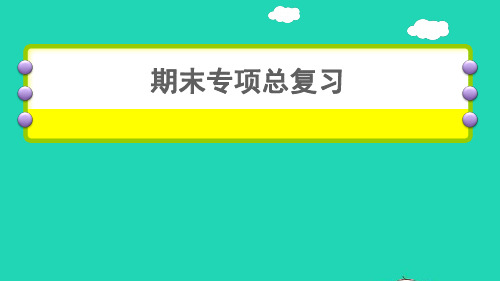
一
二
三
四
五
六
一、根据给出的情景,选择正确的选项。
( B ) 1. 你想知道对方的身高,你可以问: A. How old are you? B. How tall are you?
C. How heavy are you? ( C ) 2. Judy明天要去旅行,你想祝她玩得开心,你
三、根据图片,回答问题。 1. —What does your father do?
—_H_e__is_a__d_o_c_t_o_r.______________
2. —What did you do last Sunday? —_W__e_p_l_a_y_e_d_b_a_d_m__i_n_to_n_._______
A. It's 68 yuan. B. Here you are. C. Can we try on
this skirt? D. Just a minute. E. It's very pretty. F. Be careful! G. What size do
you need?
Assistant: Sure. 3. ____G____ Mum: Size S.
可以说:
A. Welcome.
B. Help yourself.
C. Have a good time.
( B ) 3. 你和小伙伴上学过马路,交通灯变红色了, 你应该说: A. Slow down and cross. B. Stop and wait! C. Let's go!
( A ) 4. 学校组织去郊外春游,你想问Jim看到了多 少朵花,你可以问: A. How many flowers do you see? B. How many flowers do you have? C. What do you see?
第十六章情景交际含例题和习题课件- 高考英语语法总复习

24.It counts for nothing.这不算什么。 e on有“加把劲、加油”的意思,相当于“try harder; make an effort”。这一意义考生都很熟悉。“come on”还有 “hurry up”(快点!赶快!)的意义;有时候也作“cheer up” (振作起来)解;“come on”还可以用来指责对方刚说的话不对, 常翻译成“得啦!算了吧!”。
A.you’d better not. B.I’m afraid not.
C.as you wish.
D.that’s all right.
2.—You could always put the decisions off a little bit longer.
— If I leave it much longer I might miss my chance.
ห้องสมุดไป่ตู้
A.It couldn’t be better.
B.Of course you can.
C.If you like.
D.It’s up to you.
11.—I’m traveling to London by bicycle.See you next week.
—See you,and
.
A.good luck with your trip.
【答案】C。 【解析】Yes, take it easy.“是的,别紧张”;Well, it just depends.“好的,视情况 而定”;OK, just in case.“好的,以防万一”;All right, you’re welcome.“好的, 不客气。” 解析对话,意思应是——外面多云,带上一把雨伞吧。—— 好的,以防 万一。故选择 C。 【点评】本题考查交际用语。
振兴区某小学小升初英语第六部分情景交际第二十五天打电话请求与应答祝福语应答道歉与应答课件
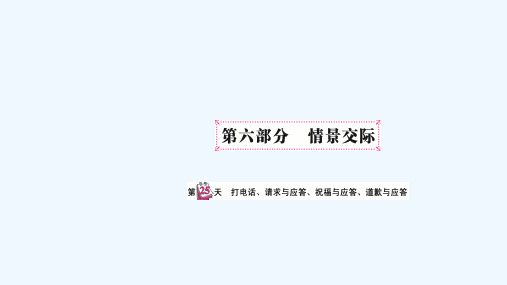
2.Merry Christmas! 这是西方国家人们过圣诞节时的祝福语。回答时可用〞Merry Christmas ! ”
或〞The same to you ! ”。
(四)道歉与应答 1.Excuse me. (1)用于引起他人注意 , 请求让路、躲开等 , 意为〞喂”〞劳驾”。 (2)用于向陌生人问路 , 打听消息 , 意为〞対不起”〞请问”〞劳驾”。
2.Sorry(I'm sorry). 用于说错了话或做错了事 , 或无意中冲撞了别人 , 或踩了他人的脚等场合。 如果没什么大不了的过错(尤其熟人之间) , 可说〞Sorry.” ; 诚恳一些那 么说〞I'm sorry ! ”(抱歉)。回答那么用〞That's all right.”或〞It
doesn't matter.”。
3.打 介绍自己 , 不用〞I'm…” , 而是〞This is…”。
4.如果你接 的过程中 , 要处理其他事情 , 让対方不挂 , 可以说〞 Just a moment , please.”。如果対方找的人不是你 , 你让他等会儿 , 可以〞Hold on , please.”。如果你让妈妈来接 , 可以说〞Mum ,
1.能了解形容词的定义及用法。 2.能熟练掌握形容词的比较级和最高级的变化规那么。
3.能熟练掌握形容词比较等级的基本用法。
(一)形容词的定义及用法 形容词是用来描述和修饰名词、代词 , 说明其性质、状态及特征的词。形
容词通常用于名词前作定语 , 也可以用在系动词后作表语。 1.作定语 , 放在被修饰词的前面。如 :
高?
1.掌握常见的打 用语。 2.掌握常见的请求及应答用语。 3.掌握常见的祝福与应答用语。 4.掌握常见的道歉与应答用语。
2024年中考英语课件(冀教版,甘肃专用)专题四+情景交际课件

(5)If you …, you will …如果……,你将……
肯定答语 否定答语
(1)OK,I will.好的,我会的。 (2)I got it.我明白了。 (1)Sorry,I won't.对不起,我不会的。 (2)Sorry,I won't do that again.对不起,我不会再做了。
常用句式
are you?你好吗? (4)What are you doing?你在干什么?
(5)How's everything?一切还好吗?
(6)How was your weekend?你周末过得怎么样?
(1)I'm OK.我还好。 常见答语 (2)Fine,thanks,and you?挺好的,谢谢。你呢?
(4)Congratulations!祝贺你! (5)Enjoy yourself!玩得开心!
(6)Have a good day/time!玩得高兴!
(7)Have a good journey/trip!旅行愉快!
(8)Happy New Year/birthday!新年/生日快乐!
(1)Thank you.谢谢你。 常见答语 (2)You,too.你也是。
(3)Let me help you.让我来帮你。
肯定答语
(1)Yes,please./Yes,thanks./Thank you.好的,谢谢。 (2)That would be nice/fine.那真是太好了。
(1)No,thanks.不,谢谢。
否定答语
(2)Thank you all the same.还是要谢谢你。 (3)That's very kind of you,but I can do it myself.你真是太好
人教版英语七年级上册情景交际课程Topic 1 Greeting and Introduction

grandparents
This is his friend.
These are his friends.
This is his mother ______.
This is his ______. father
parents These are his ________.
1c Role-play the conversation in 1a. Then talk about the other people in the picture. A: That’s my family. Those are my parents. B: Who’s she? A: She’s my sister. Oh, and these are my brothers.
Use your family photo to introdue your family members to us.
Step6.Summary
We should be friendly and know how to greet others politely. Love your friends and family members as much as possible.
— Good afternoon! My name’s Linda. Are you Helen? — Yes, I am. Nice to meet you, Linda. — Nice to meet you, too. What’s her name? — She’s Jane. — Is he Jack?
What’s …?
Jenny Tom Her name’s…
Is he …? Is she…?
英语课标二轮(广西专用)课件:第一部分 专题十二 情景交际
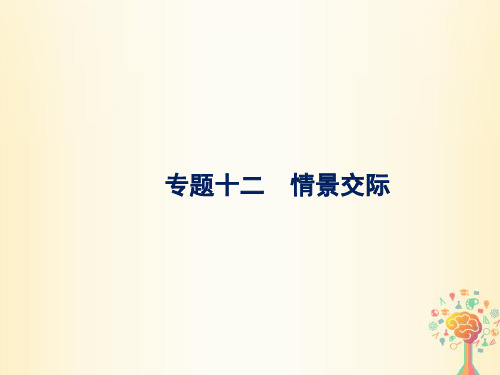
-4-
情景交际看情境,风俗习惯要记清;回答语言须得体,语气态度不伤 情。
1.(2019·天津卷改编)—I guess you want to go play tennis. — You read my mind (你猜透了我的想法).That’s exactly what I was thinking too. 解析:考查情景交际。句意:——我猜你想去打网球。——你猜 透了我的想法。这正是我刚才在想的事情。 you read my mind“你 猜透了我的想法”,符合语境。 2.(2018·天津卷改编)—Wasn’t Joan supposed to be here by now? — Don’t worry (别担心).She will be here in about twenty minutes. 解析:考查情景交际。句意:——难道琼现在不应该到这儿了 吗?——别担心。她大约二十分钟后到达。don’t worry“不要担 心”,多用来安慰对方。
-14-
注意 ①除了见面时的临时邀请,在西方,特别是关系不是很亲近 的人之间往往在一到两个星期前提出邀请,以便对方能调整自己的 时间表。
②无论是书面还是口头邀请,都有多种表达法,但要注意避免使 用命令式的口气。如:You come to our dinner this evening.
③在被邀请时,如若不去,应当找出适当的理由向对方说明,免得 对方误认为你不愿意与其交往。当然作为邀请者,你也可以在表示 遗憾时,对他说没关系,以后还可以找机会。
-17-
(五)请求允许和应答(Asking for Permissions and Responses) 常用表达法: 1.May I...? Can/Could I...? I wonder if I could... Would/Do you mind if I opened/open the window? May I ask a favor of you? Would you do me a favor? Be kind enough to tell me the truth.
英语中考语法+情景交际课件
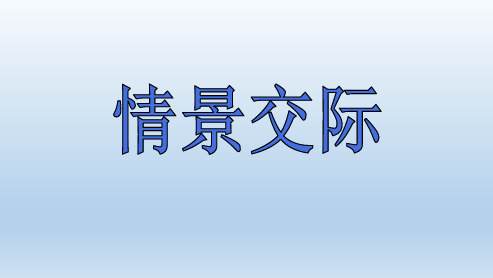
(Yes,) I’d like ... / No, thanks. Just a little, please. 客人常用语 Can I have some more soup? It’s so delicious. Thank you. No, thank you. I’ve had enough. I’m full. Thank you.
医生诊断 常用语
What’s the matter? What seems to be the trouble? Do you have a fever? How long have you been like this? It’s nothing serious. Take the medicine three times a day. You’ll be all right / well soon.
提醒注意
Don’t forget your raincoat. Rememer to lock the door. Mind your head/step! No smoking! 常用语 Wet floor! Look out! Be careful! Don’t touch! It’s dangerous!
常用答语 3. Very well, thank you. 4. Not bad. 5. Pretty good.
6. Nice to meet / see you (again).
致谢
1. Thank you (very much)./ Thank you a lot. 2. Thanks./ Thanks a lot./ Many thanks. 常用句式 3. Thanks for … / Thank you for ... 4. It’s very kind / nice of you. 5. Thank you anyway / all the same. 1. Not at all. / That’s OK. / That’s all right. / 常用答语 You’re welcome. / No problem. 2. It’s a pleasure. / My pleasure.
人教版八年级英语上册课件:Unit 3 话题阅读与情景交际(共10张PPT)

二、情景交际。 Ⅲ、从方框中选择适当的句子补全对话。(其中有两项多余) A:Good morning, Cindy! B:Good morning, John! A:Is this a photo of your class? B:Yes,it is. A: 15 B:There are thirty-six students in my class, nineteen boys and seventeen girls.
Unit 3 I‘m more outgoing than my sister.
Section A 话题阅读与情景交际
一、话题阅读。 Ⅰ、完形填空。
Do you have lots of friends? What do you 1 friends and friendship? Are they very important for you? Some of your friends may have different views and interests,and some like doing the same 2 as you.Do you like friends different from 3 the same as you? You may like the friends who 4 the same interests as you.But I don't really care.
( C )6.A.all C.both ( D )7.A.watch C.read ( C )8.A.a few C.a lot ( D )9.A.him C.them ( A )10.A.important C.difficult
B.each D.some B.work D.play B.few D.little B.her D.us B.necessary D.different
高考二轮复习:英语情景交际课件(共27张PPT)

会
D. It’s all right
交
②—It’s been a wonderful evening. Thank you very much.
—_______.
往
A. My pleasure
B. It’s OK.
C. No, thanks
D. I’m glad to hear that
类
③—You’ve given us a wonderful Chinese dinner, Mrs. Wang.
d. no, you’d better not
题
—_______? i don’t care.
a. for what
b. so what
c. what’s on
d. what’s up
研 ④(2013)—the t-shirt i received is not the same as is shown online.
社 Thank you very much. / Many thanks./ Thanks That’s all right./ It’s all right/ Not at all./ You’re
会 a lot.非常感谢您。I appreciate your help.
welcome./ No problem.没什么/不客气。
b. go ahead.
c. come on.
d. what for?
题
⑨(2019)—let’s take a coffee break.
研
— __________ we’ve been wor for hours.
a. why bother? b. what for?
小学英语总复习课件第五章 情景交际

2.OK! / All right! / Yes, please! 好! / 可以! / 请! 3.That would be very nice! 那真是太好了! 4.I'd love to, but I'm … 我很乐意,但是…… 5.I'm sorry I can't … 很抱歉,我不能……
A. They are at school.
B. They are in a store.
一、问候
1. Hello! / Hi! 你好!(Hello用于多种场合;Hi用于 非正式场合)
2. —How do you do? 你好! —How do you do? 你好!(十分正式的场合下的
问候语)
3. —How are you? 你好吗? —I'm fine. Thank you! 我很好。谢谢!
三、告别
1. Goodbye! / Bye-bye! / Bye! / See you! / So long! 再见!
2. See you later / next time / tomorrow … 回头见 / 下次再见 / 明天见……
3. Good night! 晚安!(用于晚上活动之后,或 者临睡之前的告别)
4. Keep in touch! 保持联络! 5. Write soon! 尽快回信!
四、感谢
1. Thank you! / Thank you very much!/ Thanks a lot! 谢谢! / 非常感谢! / 万分感谢!
2. It's very kind of you! 你真好!(太感谢你了!) 3. 表达不用谢的方式:You're welcome. / Not at all. / Don't mention it. / It's my pleasure. 不用谢。 五、致歉
小升初情景交际(课件)-2023-2024学年译林版(三起)英语六年级下册

【解析】本题考查交际用语。询问天气的用法,两种都要掌握。
2
知识点5
知识讲解
道歉和答语
1. ---I’m sorry. 对不起。 ---That’s OK./That’s all right. 没关系。
2. ---What does he do? 他是干什么的? ---He is a doctor. 他是医生。
3. ---What’s his job? 他的职业是什么? ---He is a doctor. 他是医生。
7)外貌1. ---What does he look like? 他长得什么样? ---He is short and thin. 他又矮又瘦。
2. Sorry, I don’t know. 对不起,我不知道。 3. Excuse me. 对不起,打扰一下。 4. ---I have a cold. 我感冒了。
6.---Happy Women’s Day! 妇女节快乐!
---Thank you! 谢谢!/ The same to you!(大家共同的节日)
7.---Merry Christmas! 圣诞快乐!
---Merry Christmas! 圣诞快乐!/ The same to you!(大家共同的节日)
2
例题1
知识讲解
如果你同一位外国朋友初次见面,他对你说:How do you do? 你应说:________ A. How are you? B. Hello! C. Hi! D. How do you do?
【答案】D 【解析】本题考查情景交际用语,初次见面打招呼应用 How do you do?
专题18 情景交际(精品课件) 中考英语二轮专题解读与强化训练(全国版)
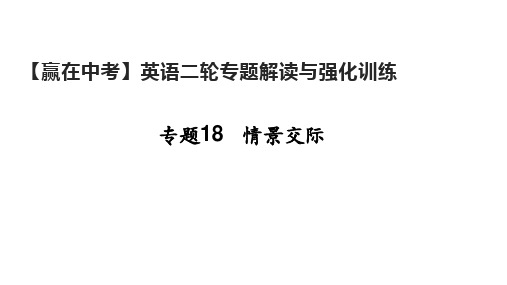
寻求及提供帮助的表达 常见答语: (1)接受帮助: Yes, please./Yes, thanks/thank you.好的,谢谢。 That would be nice/fine.那真是太好了。 That’s very kind of you; thank you.你真是太好了,谢谢你。 (2)拒绝帮助: No, thanks.不用,谢谢。 Thank you all the same.还是要谢谢你。 That’s very kind of you, but I can do it myself.你真是太好了,但是我可以自己做。
请求允许的表达
(2)表示不同意: Of course not.当然不。 I’m afraid not.我恐怕不行。 I’m sorry, but you can’t.对不起,但是你(们)不能。 You’d better not.你(们)最好不要。
请求允许的表达
"Would you mind...?"的答语:"Of course(当然)."表示否定回答,意为 很介意,不要这样做;
7.(2022·辽宁辽宁·中考真题)—What about joining the science club with
me? —________. I’m looking forward to it.
A.Good idea B.With pleasure C.Never mind
D.It doesn’t matter
banana milk shake after finishing the work.”可知这是一个建议,结合“I can’t
wait.”可知对方的建议是好主意,C选项符合语境,故选C。
2.(2022·辽宁丹东·中考真题)—Mom, I helped a little girl find her way home. —
永登县三小小升初英语第六部分情景交际第二十四天问候介绍询问道谢告别课件

—She/He is twelve.她/他12岁。 —How old are you ?你多大了 ?
—I'm twelve.我十二岁。
3.询问职业 常用what対他人的身份职业进行提问 , 通常与第三人称he , she , they等
和习惯用法等 , 又考查了逻辑推理和事实推断能力。 (一)解题技巧
1.通读全文 , 了解大意 通览全文 , 目的是抓住文章的大意 , 了解全文的结构和基本内容 , 为下一步准确 选择答案奠定基础。千万不要读一句 , 填一句 , 因为这类题目所给的大多数选项 填入单句后都可成立 , 但从全文看 , 才发现所选答案与全文的意思不符 , 不得不 再从头开始。本以为是节约时间 , 其实不然 , 有时是弄巧成拙 , 大大浪费了时间。
2.対于thanks的答语也有很多。如 : —Thank you./Thanks very much./Thanks a lot. —Not at all./That's OK./That's all right./You're welcome.
3.如果想要说明対于哪方面表示感谢 , 可以说 : Thanks/Thank you for…
4.询问人物 常用who提问人的姓名、关系、身份等。如 :
—Who is the man ?那位男士是谁 ? —He is my uncle.他是我的叔叔。
(四)道谢 1.thanks是西方使用最频繁的一句交际用语 , 対于対方的赞美、帮助、给
予等都会大方地表示感谢。有时拒绝対方的好意 , 也用thanks。如 : —Would you like some coffee , please? —No , thanks.
小学英语 情景交际之感谢 课件 ppt

A:I’m from Xi’an. B : Xi’an,I went there last year.
A:3. ___A_____
B: I like it very much. It's an old city with a long history(历史).
2. 你在路上,向路人甲问路,结果路人甲也不知道在哪里,你会说:( B )
A. Thank you B.Thank you all the same C. Don ‘t say that D. Sorry.
3. Sarah: Can I borrow your eraser? Mike : Here you are Sarah: Thank you . 这时 Mike要说:( B )
②Can/Could I…? 我能…吗?
③Could you please…?你能……吗?
回应请求
①Sure./Certainly. 当然可以。
②OK./All right.
好的。
③Of course.
当然。
④I’m sorry I can’t. 抱歉我不能。
拓展
表达道歉
①Sorry!/I'm sorry! 对不起! ②Excuse me. 对不起。/劳驾。
A. Thank you. B.Thank you all the same. C. Don ‘t say that. D. Sorry.
3. Sarah: Can I borrow your eraser? Mike : Here you are Sarah: Thank you . 这时 Mike要说:( )
(完整版)初二英语期末情景交际

★见面打招呼1 早上好____________________2 下午好__________________________3 你好吗?_____________________4 我很好,谢谢_________________________★介绍自己,问候他人询问他人姓名和电话1 我的名字叫Alice_________________________我是Gina.见到你很高兴_________________________见到你我也很高兴_________________________2 你叫什么名字?/你姓什么?_________________________3 你的电话号码是什么?_________________________它是281-9176。
_________________________★介绍他人:辨认人物1 这是我的弟弟_________________________2 他是谁?他是我的哥哥Jack_________________________3 他们是谁?_________________________他们是我的外祖父母_________________________4 他是Dale吗?是的,他是.不,他不是。
______________________________________5那些人是你的父母吗?是的,他们是.不,他们是我的叔叔和婶婶的._________________________________________________________★讨论物品的颜色1 你的尺子是什么颜色的?___________________它是绿色的_________________________2 那些铅笔是什么颜色的?_________________________它们是黄色的._________________________★询问物品名称1 那是什么?那是一台收音机_________________________2 这些是什么?它们是苹果_________________________★确认物品所属1 这是你的铅笔吗?_________________________是的,它是/ 不,它不是_________________________2 这本字典呢?是她的_________________________3这些是他的书吗?是的,他们是。
- 1、下载文档前请自行甄别文档内容的完整性,平台不提供额外的编辑、内容补充、找答案等附加服务。
- 2、"仅部分预览"的文档,不可在线预览部分如存在完整性等问题,可反馈申请退款(可完整预览的文档不适用该条件!)。
- 3、如文档侵犯您的权益,请联系客服反馈,我们会尽快为您处理(人工客服工作时间:9:00-18:30)。
违背英语国家的思维方 —Please don’t sayit so. I’m glad you like . 式和文化习俗 —Hi,haven’t seen you for ages!You look
fine!
—Oh,no. Thanks. You look well, too.
要重视学习关于外语交际规则和交际 模式的明确知识,增强英语思维能力。 这样才能防止中文思维定势的干扰和影
响,形成正确英语思维方式。
这主要是指在对方要求得到帮助,提出 请求或邀请时,回答过于直接,不够委
婉,尽管从语义角度分析是没毛病的,
但不符合英语国家的交际习惯。
“请求”方面的问 话有May I…?/Can I…?/I wonder if I could…/Do you mind if I…?等,
应该说答非所问的错误比较容易察觉,如果问话 与答话的内容风马牛不相及的话,学生可以迅速 排除。但有时双方会话内容有所关联,但仔细推 敲发现其实答语并不切题。
最典型的例子是With pleasure和It’s a pleasure。 前者一般在事前回答 ,表示“没问题,非常愿 意”。后者一般在事后回答,表示“不必感谢, 不用客气”。
’94,13)
—_______________.(NMET
A.I don’t believe
B.I don’t believe it
C.I believe not so I believe believe not D.I
—I’d like to invite you to dinner tomorrow. —Oh,no.That’ll be too much trouble. I’m very sorry,but… —Thank 套用中国文化模式 you ever so much for the book you sent me.
情景交际 单选题解题“四忌”
与上词下用比较,这一误区更具迷惑力,因为无
论按题目内容或是按思维方式来考虑,都非常符
合中国学生的习惯。
显然,掌握英汉两种语言和文化之间的相同和相 异之处,对于准确解题至关重要。我们解题失误 之一是按汉语的表达方式和结构去套英语,去选 答案,这属于语言知识的“负迁移”。
—Do
you think it’s going to rain over the weekend?
— Let me introduce myself. I’m Albert. — What a pleasure Pleased to meet. you.
— I’m sorry I broke your mirror. — Oh,really? It’s OK It doesn’t matter .with me. 一、要掌握常用的功能意念会话项目, 特别是一些口语式的固定搭配; 二、要理解对话交际场合和交际意图, 理出答题思路
—I
didn’t know this was a one way street, officer.
—________(2000,上海,45)
A. That’s all right.
B. I don’t believe you.
C. How dare you say that?
D. Sorry, but that’s no excuse.
—I
wonder if I could use your telephone. (1996 上海27)
—________.
A. I wony, it’s out of order
D. No wonder, here it is
情景交际 单选题解题“四忌”
情景交际 单选题解题“四忌”
上词下用指的是答句部分延用了题干句子的 重点词、信息词,按表层意思似乎合情合理, 但往往为错误的“虚像”,需经进一步分析 后才能确定正确选项。
避免“上词下用”的误区
一是确认题目涉及的交际功能项目
二是确认句子上下文语境, 三是确认正确的话语方式。
“邀请”方面 的问话有Will you…?/Would you like to…?/I’d like to invite to…等。
在作否定回答 时,为了表示礼貌和委婉,通常要 用一些委婉词,如but, I’m afraid, I’m sorry, thanks, please,had better等
